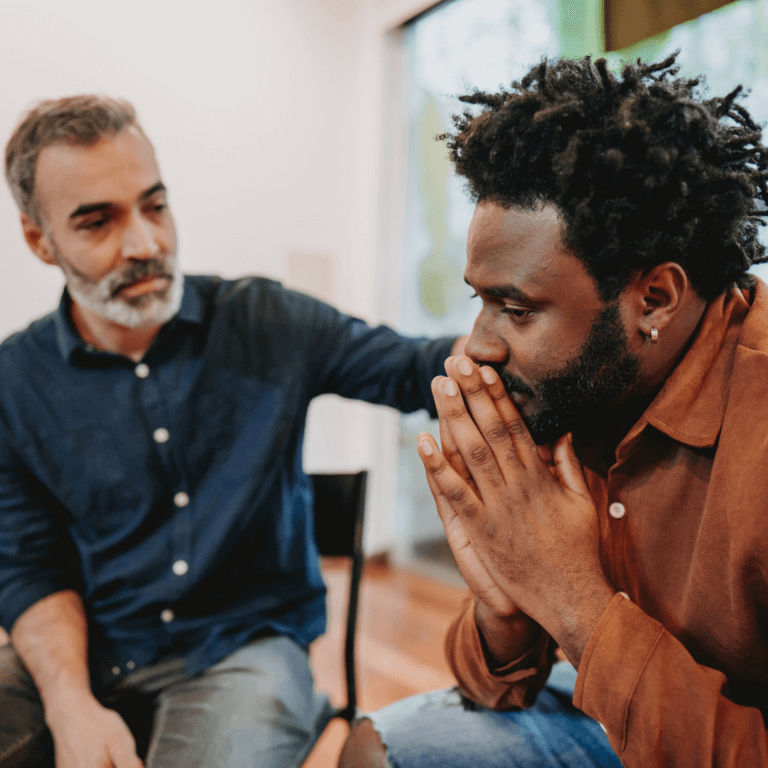Anxiety disorder may be more prevalent in women, but plenty of men also struggle with this common mental health issue. Men and women have different ways of expressing anxiety symptoms and also differ in their willingness to seek help. For lots of eye-opening information about anxiety in men, read on!
What is anxiety disorder?
Anxiety disorder is the most prevalent mental health diagnosis made in the U.S., with approximately 40 million adults experiencing the disorder each year. Under the anxiety disorder umbrella there are several subtypes:
- Generalized anxiety disorder (GAD): The main features of GAD are excessive fear and worry. These emotional states can cause insomnia, shortness of breath, jumpiness, irritability, heart palpitations, sweating, dizziness, headaches and stomach issues.
- Panic disorder: Panic disorder is characterized by frequent panic attacks. A panic attack mimics a heart attack, with chest pain, trembling, shortness of breath, hyperventilating, nausea, shaking, a sense of doom and a racing heart.
- Social anxiety: This type of anxiety features an intense fear of being judged or rejected by others, especially while in a public setting. This fear response may include sweating, blushing, muscle tension, nausea, rapid heartbeat, hyperventilating and lightheadedness.
- Phobia: Phobia is an extreme fear of a specific thing, place, person or situation. Symptoms include sweating, difficulty breathing, chest tightness, racing heart and avoidant behaviors.
- Obsessive-compulsive disorder (OCD): OCD is characterized by dysfunctional thoughts and behaviors that are driven by irrational fear. An obsessive fear triggers a strong desire, followed by the need to engage in compulsive behaviors in order to relieve the stress.
- Post-traumatic stress disorder (PTSD): PTSD is a prolonged response to witnessing or experiencing a traumatic event. When the anxiety caused by the trauma lasts more than one month, it is considered PTSD. Symptoms include irritability, flashbacks, insomnia, substance abuse, detachment, nightmares and avoidance behaviors.
How is anxiety expressed in men?
Men and women have different ways of responding to anxiety. Where women tend to be more verbally expressive when they experience anxiety, men may prefer to ignore the condition. Men avoid any appearance of weakness or seeming out of control, so they are less likely to admit that they’re struggling with anxiety.
Some of the ways that men anxiety exhibit include:
- Increased irritability and anger
- Being on edge or jumpy
- Withdrawing socially
- Sleep problems
- Increased substance use
- Strained relationships
- Appearing stressed out
- Difficulty concentrating
- Stomach issues
- Frequent headaches
- Job performance suffers
- Excessive worrying
What are the causes of anxiety in men?
Even though men might express anxiety issues differently than women, the causes of the anxiety are the same regardless of sex. Common risk factors for developing anxiety disorder include:
- Genetics: Having a close relative who struggles with anxiety disorder increases the likelihood that you will too.
- Stressful life events: A history of trauma, the death of a loved one, a divorce, a highly stressful job or financial problems can all contribute to anxiety.
- Health conditions: Struggling with a chronic or severe health problem may trigger anxiety. Some examples are diabetes, cancer, lupus, fibromyalgia and irritable bowel syndrome.
- Lifestyle factors: Like a vicious cycle, chronic stress and worry can lead to poor dietary choices, a lack of quality sleep, too little physical activity and substance use.
What are some anxiety treatment options for men?
Men who are struggling with anxiety can benefit from psychotherapy. Therapists are trained in a variety of behavioral therapies that can be helpful in guiding them towards reducing anxiety in their everyday activities.
In addition to therapy, getting regular exercise stimulates the neurotransmitters that reduce anxiety and stress. Also, maintaining a nutritious diet that is low in sugar, alcohol and processed foods helps to stabilize blood sugars. Finally, engaging in holistic activities on a regular basis, such as meditation, deep breathing or yoga, can keep anxiety in check.


